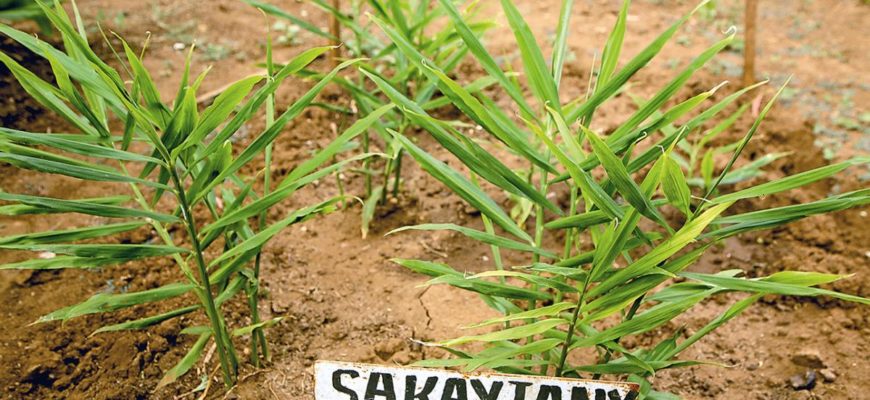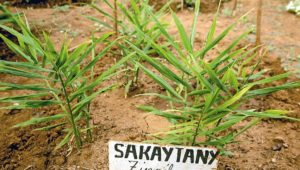
Find out more about the Ginger plant of our Aromatherapy Herbarium blog series.

GINGER
Zingiber officinale
DESCRIPTION

Ginger (Zingiber officinale), a perennial tropical native of Malabar (India) belongs to the Zingiberaceae family.
ADVICE
Essential oil of ginger does not have a very pleasant odour in diffusion. For cooking, one drop of essential oil is enough to perfume a dish for five to six persons.
DO NOT USE IN
– pregnant or breast-feeding women,
– children under the age of three years,
– persons allergic to one of the components (geranial, limonene, neral),
– subjects with asthma without the advice of an allergologist before the first use,
– case of anticoagulant treatment or before surgery.
RECIPES
Hair loss
Mix 1 to 2 drops of essential oil of ginger with your dose of shampoo.
Digestion
Mix 3 drops of essential oil of ginger in 3 drops of carrier oil.
Apply by massaging the abdomen.
Athlete massage
10 drops of EO of ginger, 10 drops of EO of rosemary, 5 drops of arnica CO. Mix the oils and have a massage before and after exercising.
Stimulation of libido
Apply at the bottom of the back and along the spinal column 3 drops of essential oil of ginger diluted in 1 drop of neutral carrier oil, three times daily.
Take 1 drop of essential oil of ginger on a neutral tablet three times daily for three weeks.

It is about ninety centimetres tall; its persistent leaves are lanceolate. The plant grows from a fleshy and well developed rhizome divided in nodes, which is used in medicine and cooking. After flowering, a club-like spike containing encapsulated seeds appears at the tip of a short scaled stem. The leaves are very fragrant when crushed.
Described over more than three thousand years, especially in the Vedic texts, ginger has been the major remedy of Indian medicine to treatment digestive disorders since time immemorial. Women consumed it during pregnancy to prevent nausea. It was one of the exotic spices, along with pepper, clove and cinnamon, with potent odour and flavour that the Romans went to find in the East to spice their cooking and preserve their meats. It is thus in a high position in the “list of essential spices for the home” written in the 1st century A.D. by the famous gourmet Apicius. Dioscorides and Pliny also attribute aphrodisiac properties to ginger. Its root, in the “Edict of Maximum” from 301 A.D., must be sold 400 denarii a pound, the high price being indicative of its scarcity.
CULTIVATION AND PRODUCTION
In France, ginger has been cultivated since the 19th century in the region of Montpellier. India produces more than a quarter of the world production, followed by many warm and humid climate countries. The “citral” variety is produced by Sub-Saharan Africa and Japan. The harvest of the rhizomes takes place before the first frosts if cultivated in fields, or as soon as the leaves dry if cultivated in hothouses, i.e. nine months after planting.
FRAGRANCE
The odour of ginger is characteristic, warm and spicy and certain species have a citrus note.
EXTRACTION AND YIELD
Essential oil of Zingiber officinale is obtained by total steam distillation of the dried or fresh rhizome. The yield varies, depending on the batch, between 1.5% and 3%, i.e. a kilogram and a half to three kilograms per hundred kilograms of plant.
CHEMICAL FORMULA
Ginger contains two major chemical categories, sesquiterpenes the most common, and the other citral. The main active constituents of the first are principally monoterpenes (camphene), monoterpenols (borneol, geraniol, linolool), sesquiterpenes (ar-curcumene, betasesquiphellandrene and zingiberene).
MAIN INDICATIONS
Essential oil of ginger is traditionally used for its tonic effects. It favours general fitness by dissipating fatigue, either physical or mental. Sexual tonic, it is considered to be an aphrodisiac; it arouses male or female libido. Digestive tonic, it facilitates digestion, limits flatulence and constipation. Hair tonic, it fights hair loss and stimulates their growth. Anti-nausea, it prevents “travel sickness”. It is mainly its anti-inflammatory properties that have been validated from a scientific point of view.


Leave a Comment